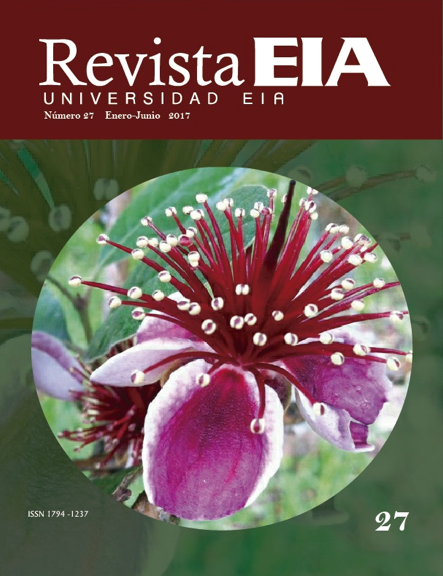Evaluación heurística de la usabilidad de software para facilitar el uso del computador a personas en situación de discapacidad motriz
Evaluación heurística de la usabilidad de software para facilitar el uso del computador a personas en situación de discapacidad motriz
Barra lateral del artículo
Términos de la licencia (VER)
Declaración del copyright
Los autores ceden en exclusiva a la Universidad EIA, con facultad de cesión a terceros, todos los derechos de explotación que deriven de los trabajos que sean aceptados para su publicación en la Revista EIA, así como en cualquier producto derivados de la misma y, en particular, los de reproducción, distribución, comunicación pública (incluida la puesta a disposición interactiva) y transformación (incluidas la adaptación, la modificación y, en su caso, la traducción), para todas las modalidades de explotación (a título enunciativo y no limitativo: en formato papel, electrónico, on-line, soporte informático o audiovisual, así como en cualquier otro formato, incluso con finalidad promocional o publicitaria y/o para la realización de productos derivados), para un ámbito territorial mundial y para toda la duración legal de los derechos prevista en el vigente texto difundido de la Ley de Propiedad Intelectual. Esta cesión la realizarán los autores sin derecho a ningún tipo de remuneración o indemnización.
La autorización conferida a la Revista EIA estará vigente a partir de la fecha en que se incluye en el volumen y número respectivo en el Sistema Open Journal Systems de la Revista EIA, así como en las diferentes bases e índices de datos en que se encuentra indexada la publicación.
Todos los contenidos de la Revista EIA, están publicados bajo la Licencia Creative Commons Atribución-NoComercial-NoDerivativa 4.0 Internacional
Licencia
![]()
Esta obra está bajo una Licencia Creative Commons Atribución-NoComercial-NoDerivativa 4.0 Internacional
Contenido principal del artículo
Resumen
Descargas
Detalles del artículo
Referencias (VER)
Abran, A., Khelifi, A., Suryn, W., & Seffah, A. (2003l). Consolidating the ISO usability models. Proceedings of 11th international software quality management conference. Glasgow, Scotland, UK. pp. 23-25.
An, K. O., Kim, D. H., & Kim, J. (2013). Development of a Virtual Keyboard System Using a Bio-signal Interface and Preliminary Usability Test. Human-Computer Interaction. Towards Intelligent and Implicit Interaction. Springer Berlin Heidelberg. pp. 3-9.
Aipo,A. I. (2002). Promoción de la Internación Personal-Ordenador, la Usabilidad y el Diseño centrado en el usuario. Libro IPO, El Diseño Ubicuo. Madrid, España.
Barreto, A. B., Scargle, S. D., & Adjouadi, M. (1999). A real-time assistive computer interface for users with motor disabilities. ACM SIGCAPH Computers and the Physically Handicapped. 64. pp. 6-16.
Bradford, J. S. (1994, June). Evaluating high-level design: Synergistic use of inspection and usability methods for evaluating early software designs. Usability inspection methods. New York, USA. John Wiley & Sons, Inc. pp. 235-253.
Camargo, M., Wendling, L., & Bonjour, E. (2014). A fuzzy integral based methodology to elicit semantic spaces in usability tests. International Journal of Industrial Ergonomics, 1. pp. 11-17.
Faulkner, L. (2003). Beyond the five-user assumption: Benefits of increased sample sizes in usability testing. Behavior Research Methods, Instruments, & Computers, 3. pp. 379-383.
Ferré Grau, X. (2005). Marco de integración de la usabilidad en el proceso de desarrollo software. Tesis Doctoral. Universidad Politécnica de Madrid, Madrid.
Grau, X. F. (2000, November). Principios Básicos de Usabilidad para Ingenieros Software. V Jornadas de Ingeniería del Software y Bases de Datos.Valladolid, España. pp. 39-46.
Gajos, K. Z., Wobbrock, J. O., & Weld, D. S. (2008, April). Improving the performance of motor-impaired users with automatically-generated, ability-based interfaces. Proceedings of the SIGCHI conference on Human Factors in Computing Systems. New York, USA. ACM. pp. 1257-1266.
Holzinger, A. (2005). Usability engineering methods for software developers. Communications of the ACM, 48, pp. 71-74.
Hornof, A. J., & Cavender, A. (2005, April). EyeDraw: enabling children with severe motor impairments to draw with their eyes. Proceedings of the SIGCHI conference on Human factors in computing systems. New York, USA. ACM. pp. 161-170.
Istance, H. O., Spinner, C., & Howarth, P. A. (1996). Providing motor impaired users with access to standard Graphical User Interface (GUI) software via eye-based interaction. Proceedings of the 1st European Conference on Disability, Virtual Reality and Associated Technologies. Maidenhead, UK. pp. 109-116.
Jokela, T., Iivari, N., Matero, J., & Karukka, M. (2003, August). The standard of user-centered design and the standard definition of usability: analyzing ISO 13407 against ISO 9241-11. Proceedings of the Latin American conference on Human-computer interaction. New York, USA. ACM. pp. 53-60.
Keates, S., Clarkson, J., & Robinson, P. (2000, November). Investigating the applicability of user models for motion-impaired users. Proceedings of the fourth international ACM conference on Assistive technologies. New York, USA. ACM. pp. 129-136.
Keates, S., Langdon, P., Clarkson, P. J., & Robinson, P. (2002). User models and user physical capability. User Modeling and User-Adapted Interaction, 12. pp. 139-169.
Koester, H. H. (2003, June). Abandonment of speech recognition by new users. Procedure Rehabilitation Engineering and Assistive Technology Society of North America. Salt Lake City, UT. Vol. 3.
Law, C., Sears, A., & Price, K. (2005). Issues in the categorization of disabilities for user testing. Proceedings International Conference on Human-Computer Interaction. Las Vegas, USA.
Lazar, J. (Ed.). (2007). Universal usability: Designing computer interfaces for diverse user populations. Chichester, England. John Wiley & Sons.
Lorda, S., & eta Concheiro, P. (1993). L. El consentimiento informado: teoría y práctica. Medicina Clinica. 100, pp. 659-663.
Lynch, K. R., Schwerha, D. J., & Johanson, G. A. (2013). Development of a weighted heuristic for website evaluation for older adults. International Journal of Human-Computer Interaction, 29. pp. 404-418.
Macleod, M., & Rengger, R. (1993). The development of DRUM: A software tool for video-assisted usability evaluation. VIII, proceedings of the HTC 93 Conference. Loughborough. UK. Pp. 293-293.
Nielsen, J. (1994, April). Usability inspection methods. Conference companion on Human factors in computing systems. New York, USA. ACM. pp. 413-414.
Nielsen, J. (1994). Jakob Nielsen, Usability Engineering, San Francisco, CA, Morgan Kaufmann Publishers Inc.
Nielsen, J. (1994, April). Usability inspection methods. Conference companion on Human factors in computing systems. New York, USA. ACM. pp. 413-414.
Phillips, B., & Zhao, H. (1993). Predictors of assistive technology abandonment. Assistive Technology, 5. pp. 36-45.
Scherer, M. J. (2002). The change in emphasis from people to person: introduction to the special issue on Assistive Technology. Disability and rehabilitation, 24. pp. 1-4.
Seffah, A., Donyaee, M., Kline, R. B., & Padda, H. K. (2006). Usability measurement and metrics: A consolidated model. Software Quality Journal, 14. pp. 159-178.
Trewin, S., & Pain, H. (1999). Keyboard and mouse errors due to motor disabilities. International Journal of Human-Computer Studies, 50. pp. 109-144.
Wobbrock, J. O., Kane, S. K., Gajos, K. Z., Harada, S., & Froehlich, J. (2011). Ability-based design: Concept, principles and examples. ACM Transactions on Accessible Computing (TACCESS), 3. pp. 9.


 PDF
PDF
 FLIP
FLIP







